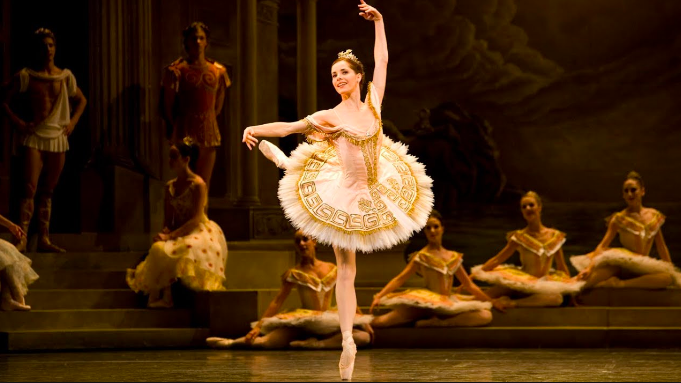The Royal Opera House‘s screening of the Royal Ballet’s Sylvia at the new Linbury Theatre was personally presented by Dame Darcey Bussell who gave a pre-show talk on her memories of recreating this magical Ashton ballet and performing alongside Roberto Bolle.
Frederick Ashton originally created Sylvia in 1952 to showcase the talents of Prima Ballerina Assoluta Dame Margot Fonteyn, however the ballet was lost until it was recreated on Darcey by Christopher Newton.
The remaking of Sylvia came just after Darcey’s second child and she talked about the difficult requirements of Ashton’s fast, intricate and exacting footwork together with the lyrical and fluid upper body movements that is the trademark of this prolific choreographer. Darcey also described the challenge of recreating Ashton’s original steps from a mixture of old, incomplete and poor quality film.
The Royal Ballet’s revival of Sylvia was performed in 2005 and the screening showcased Darcey dancing with Roberto Bolle, who she called her ‘Italian stallion’! Roberto and Darcey’s beauty is perfectly matched with his masculine physic and effortless perfect execution and her elegant long limbs, her precision and immaculate artistry which is enjoyed even more close up on screen.
Having Darcey share her experiences and insights provided a deep and special context to viewing the film. She shared the challenges of returning after her second child, the months of work to build up the stamina required to perform Ashton’s intricate and beautiful work. Darcey loved the role that enabled her to showcase a complex woman who was a strong leader, a warrior, a seductress, and ultimately a woman who falls in love.
The ballet is captivating with a narrative that moves at pace created by Ashton’s quick movements and musical elements. Interestingly, the original production of Sylvia wasn’t a success on opening night, but today’s screening of the 2005 production was a triumph with an incredible cast, stunning sets and costumes and a dramatic musical score.
It is always an honour and informative listening to a dancer and Darcey’s experience of this ballet and her knowledge of its history coupled with her honest reminimising added to the audience’s experience of the ballet, the company and dance at the time.
Darcey talked about the differences between the three Acts from a dancer’s perspective, and how she felt at the end having performed each different element of Sylvia’s journey. Sylvia is a visual feast and Darcey and Roberto make it looks effortless.
But that effortlessness took months in the studio, and Darcey recalls asking for more and more studio time to rehearse and perfect the performance. She reflects on the graciousness and professionalism of Roberto who gave all the time needed without any ego and was disciplined and a joy to work with.
Reflecting on Ashton, Darcey explained that in order to meet his expectations, that the dancers had to go ‘full out’ in every rehearsal. That Ashton ‘wanted everything’, he wanted the tricky footwork and the lyrical fluid upper body. She reflects on him saying ‘if you’re not bending enough, you’re not doing it right’. She made the point that this is very much the style of the Royal Ballet and that it must not be lost.
And it’s these lessons that she now passes onto other Royal Ballet dancers that she has coached for this role, including Marianela Nuñez. Darcey clearly has a passion and a talent for coaching, a role that she loves as she can pass on her experience and knowledge gained throughout her esteemed career, to ensure that steps and choreographers’ details are preserved for the future.
The screening and pre-show talk by Darcey was magical and made viewing the ballet even more enjoyable as I looked for the difficult lifts Darcey spoke of, the 1 minute costume change, and the pas de deux that were special to her. It was also wonderful to see other ballet stars such as Mara Galeazzi as Diana, Thiago Soares as Orion, Sarah Lamb and other young dancers who we know go on to become today’s famous ballet stars.
The Royal Ballet’s screening programme will no doubt become as important to the ballet calendar as live performances in the Royal Opera House as audiences get an opportunity to see or relive a moment past and their favourite dancers in detail on the big screen. A truly magical experience!
Reviewed at Linbury Theatre, Royal Opera House on 7 December.


